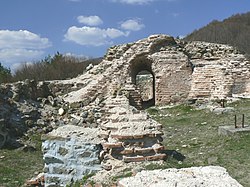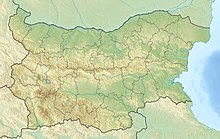| Battle of the Gates of Trajan | |||||||
|---|---|---|---|---|---|---|---|
| Part of the Byzantine–Bulgarian Wars | |||||||
 Ruins of the fortress Gates of Trajan | |||||||
| |||||||
| Belligerents | |||||||
| First Bulgarian Empire | Byzantine Empire | ||||||
| Commanders and leaders | |||||||
| Samuil of Bulgaria | Basil II | ||||||
| Strength | |||||||
| Unknown | 15,000–20,000[2] | ||||||
| Casualties and losses | |||||||
| Unknown (Light) | Unknown (Heavy) | ||||||
Location within Bulgaria | |||||||
The Battle of the Gates of Trajan (Bulgarian: Битка край Траянови врати, Medieval Greek: Μάχη στις Πύλες του Τραϊανού) was a battle between Byzantine and Bulgarian forces in the year 986.
It took place in the pass of the same name, modern Trayanovi Vrata, in Sofia Province, Bulgaria. It was the largest defeat of the Byzantines under Emperor Basil II. After the unsuccessful siege of Sofia he retreated to Thrace, but was surrounded by the Bulgarian army under the command of Samuel in the Sredna Gora mountains. The Byzantine army was annihilated and Basil himself barely escaped.
Fifteen years after the fall and re-capture of the Bulgarian capital of Preslav, the victory at the Gates of Trajan extended the Bulgarian successes achieved since 976. Later on Tsar Samuel moved the capital from Preslav in the northeast to Ohrid in the southwest. The memory of the great victory over Basil II was preserved thirty years later in the Bitola inscription of Ivan Vladislav (1015–1018), the son of Aron.
- ^ Korpela, Jukka (2001). Prince, Saint, and Apostle: Prince Vladimir Svjatoslavič of Kiev, His Posthumous Life, and the Religious Legitimization of the Russian Great Power. Otto Harrassowitz Verlag. p. 86. ISBN 9783447044578. Retrieved 15 August 2018.
- ^ Hupchick, p. 259
